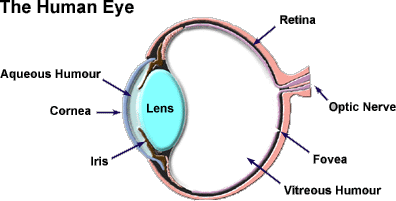Color Vision
Color is a sensation we experience when light rays of a specific frequency strike the rods and cones in the retinas of our eyes. We call this range of light frequencies the Visual Spectrum. From the Horizon up to the Dome of the Sky we can see the Visible Spectrum of colors displayed for us. Not all the parts are equal in size, but they are there. Beyond merely seeing color we perceive it, meaning that we feel it, sense it, taste it and are affected by it unconsciously.
The human visual system can detect the range of light spectrum from about 400 nanometers (violet) to about 700 nanometers (red). Our visual system perceives this range of light wave frequencies as a smoothly varying rainbow of colors. The following illustration shows the Visual Spectrum approximately as a typical human eye experiences it.
Visual Spectrum

The human eye has a lens and iris diaphragm which serve similar functions to the corresponding features of a camera. In other respects the eye is quite different from a camera. A camera has a flat image plane where the resolution and spectral response is reasonable constant across the entire plane. The eye is not at all like that, having evolved to serve several different purposes. It provides a motion sensor system with nearly 180 degrees horizontal coverage. The eye's peripheral vision system only supports low resolution imaging but offers an excellent ability to detect movement through a wide range of illumination levels. This motion detection has been useful to human kind for protection from aggressors and for spotting game while hunting. Peripheral vision provides very little color information. The retina is a thin layer of nerve cells which consists of partially of light sensor cells. The majority of the eye's inside chamber has this retina layer, accounting for the very wide angle of our peripheral vision. The following illustration shows a cross section of the human eye.

The eye's high resolution color vision system has a much narrower angle of coverage. This system can flexibly adapt to widely varying illumination colors and levels. It evolved primarily as a daylight system and ceases to work well at very low illumination levels.
Full Electromagnetic Spectrum
 |
The Visible Spectrum |
Some Gender Differences To Take Note Of
Stereotypes about the superior color sense of women may well be rooted in genetics. Brian Verrelli, a researcher at the Biodesign Institute at ASU, is co-collaborator on a study suggesting that natural genetic selection has provided women with a frequent ability to better discriminate between colors than men.
The results focused on the gene that allows people to perceive the color red, a gene that is found only on the X chromosome. They found that the gene has maintained an unusual amount of variation, that is about three times that of other genes. "Normally, this degree of genetic variation is suppressed through natural selection," Verrelli says. "In this case, nature is supporting a high degree of variation instead." Verrelli explains that variation in the red gene is created via the exchange of genetic material with a neighboring gene that detects green.
The scientists speculate that enhanced color perception was important when women were the primary gatherers in the hunter-gatherer phase of human existence. It would have allowed them to better distinguish among fruits, foliage and insects. Therefore, nature supported the variation, despite some negative consequences to men.
Because women have two X chromosomes, women can receive one chromosome with the typical configuration of the red vision gene while the other chromosome receives a slight variation. It is the combination of a normal and variant gene, which occurs in about 40 percent of women, that may provide a broader spectrum of color vision in the red-orange range. By contrast, men have one X chromosome, and any variation in the single red gene that they receive reduces their ability to distinguish between red and green.
This accounts for the relatively high percentage of men - 8 percent - who have a color vision deficiency. It was this statistical aberration that first interested Verrelli in pursuing this research. "Most detrimental conditions caused by a genetic variation affect a tiny fraction of 1 percent of the population," Verrelli says. "The fact that the problem of color-blindness was so common suggested an important mitigating advantage," Verrelli says.
[Statistic 2004: 7% of men have some sort of color vision deficiency, and .04% of women.]